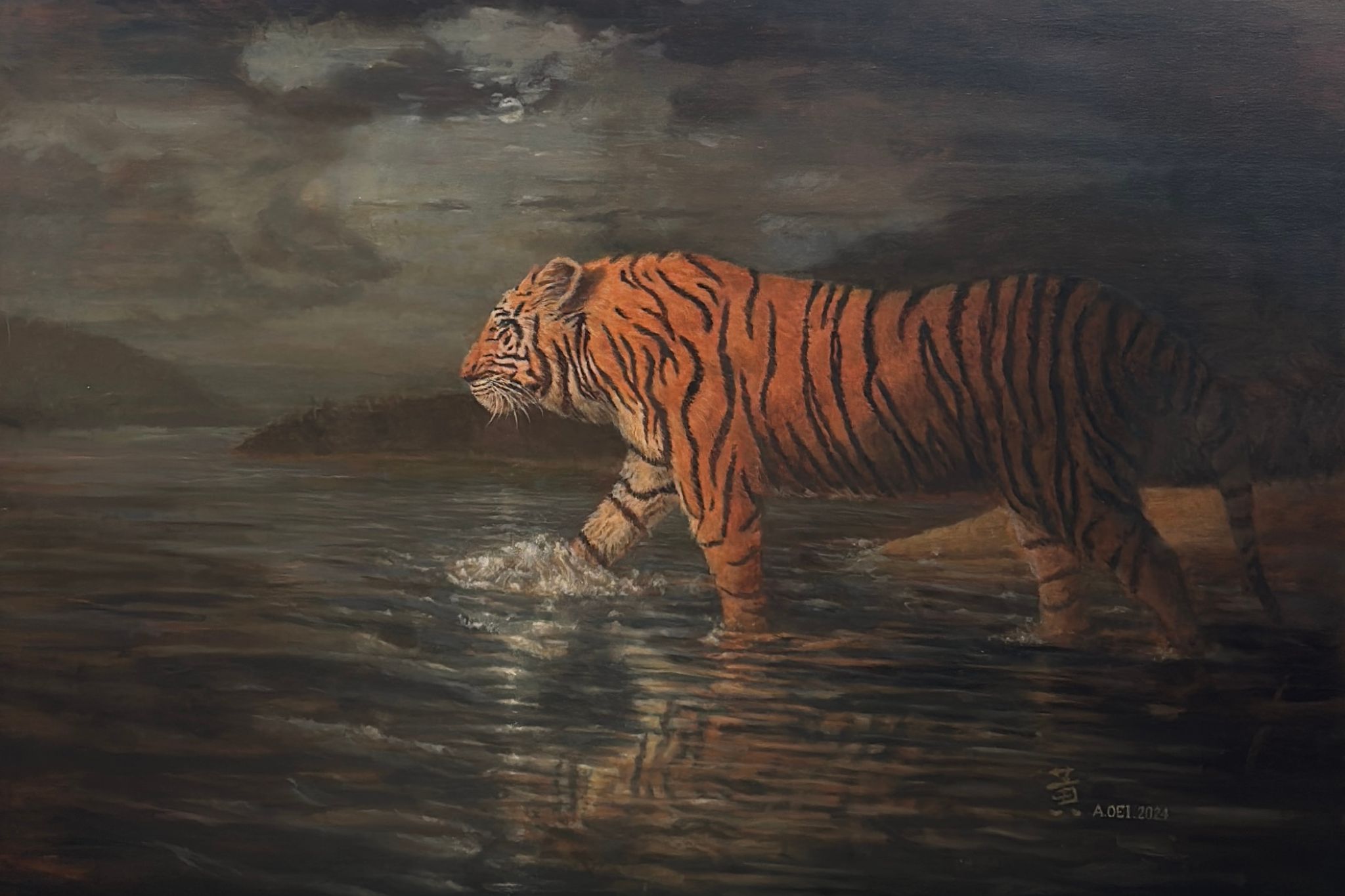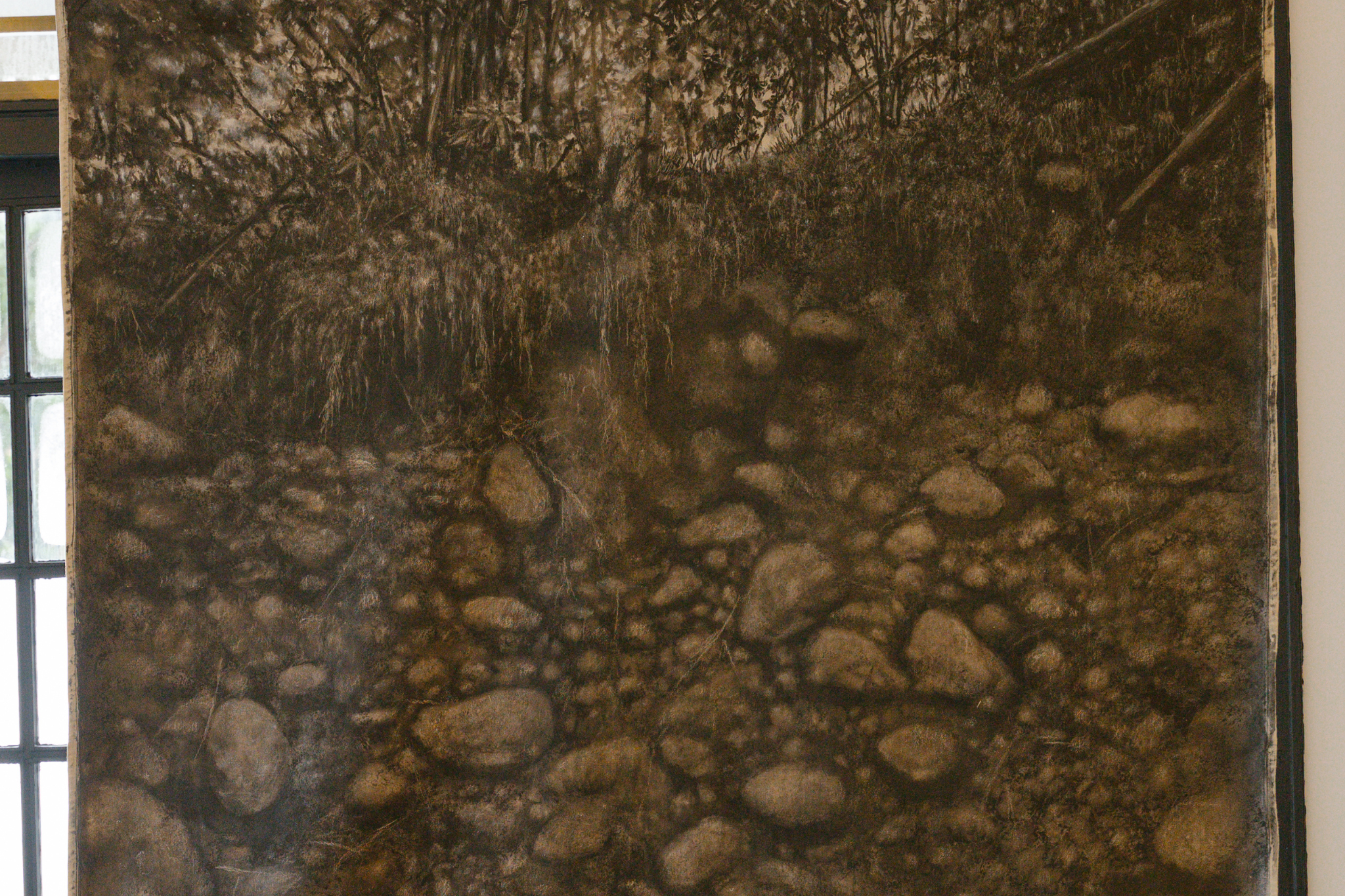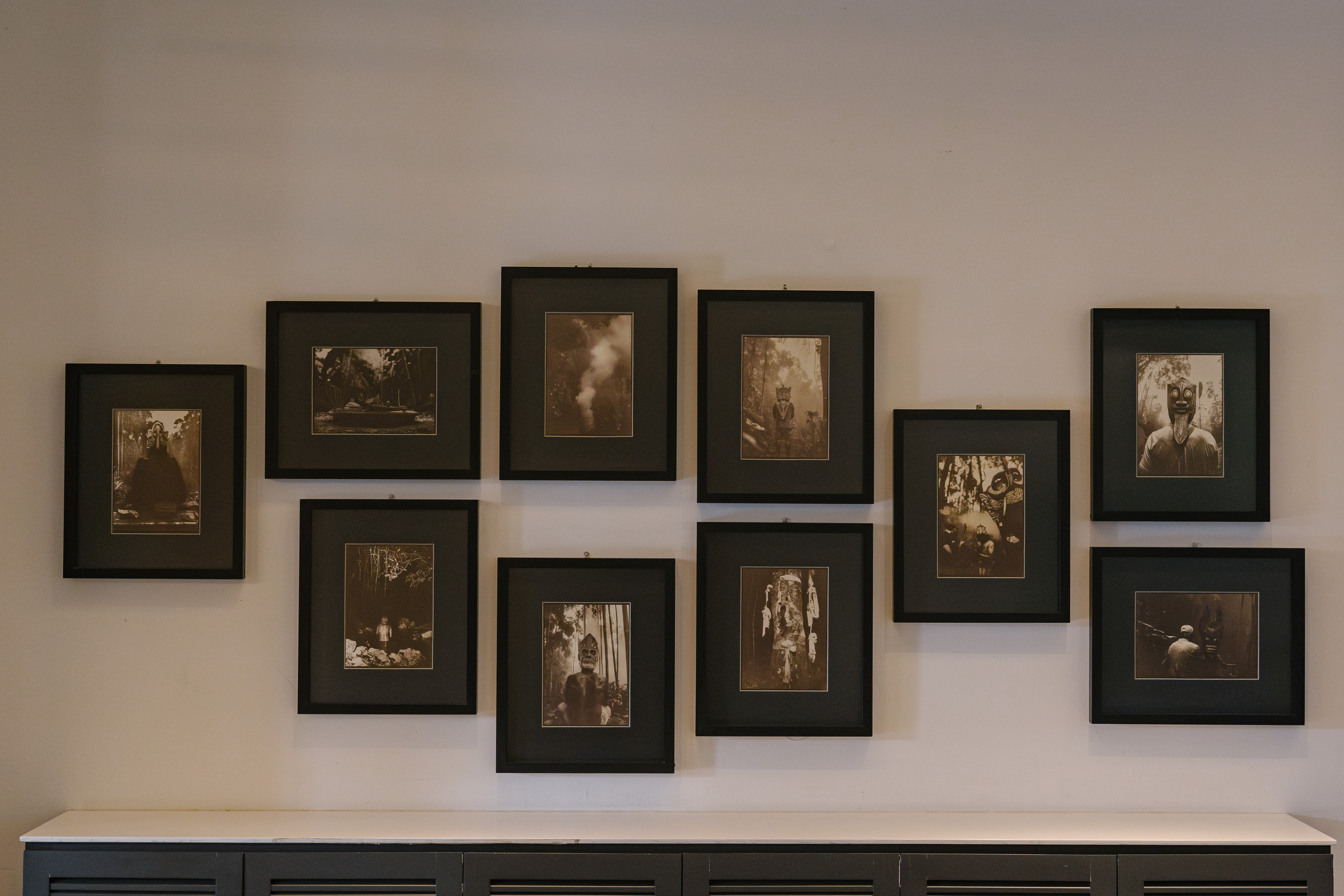The Eye and The Tiger (2025)
7 Adam Park, Art WalkWalk up to a fabled black and white bungalow nestled in a lush rolling landscape.
The form and function of the black and white bungalow take after the Anglo-Indian plantation villa,
once part of a global botanical network built on colonial practices.
Add a sprinkling of tiger killings, a dash of prisoners-of-war and a pinch of fierce battles,
and you have a recipe of alternative history that’s not so black and white.
Spread open the map and you will see two more landmarks nearby that have been forgotten in the story of our black-and- whites:
Botanic Gardens and Tiger Hill.
Discover how the colonial gaze shapes our relationship to land and nature, and how tigers have haunted us at every step.




The Gentleman in Stripes, 2024
Purposefully sited at a colonial bungalow, whose architectural form is derived from the plantation villa, it is a work that complicates our nostalgia for these architectural hangovers from colonialism.
In the first place, these bungalows reflect the colonial fear of the tropics as “the white man’s grave,” physically separating the white body from both the servants, as well as the larger native populace that was thought to be teeming with disease. In the second place, the plantation villa was at the heart of the dark history of cash crop plantations.
The work intimates the figure of George Coleman, who not only created the first survey map of Singapore (enabling the creation of plantations), but who was also attacked dramatically by a tiger. Contrary to belief that encroachment on nature caused tiger attacks, it was plantations that provided new hunting ground for tigers. In this way, Oei conjoins the history of the (plantation) bungalow with the history of tigers.
***
Alan Oei (b. 1976, Singapore) is an artist-curator whose work explores the intersection of art history and politics. He holds a BA in Art History from Columbia University and a Diploma in Fine Arts from LASALLE College of the Arts.
Alan is the artistic director of OH! Open House and has exhibited in Singapore, Malaysia, Hong Kong, Melbourne, and New York. He was formerly artistic director of The Substation (2016–2019) and Sculpture Square (2012–2014).
In the first place, these bungalows reflect the colonial fear of the tropics as “the white man’s grave,” physically separating the white body from both the servants, as well as the larger native populace that was thought to be teeming with disease. In the second place, the plantation villa was at the heart of the dark history of cash crop plantations.
The work intimates the figure of George Coleman, who not only created the first survey map of Singapore (enabling the creation of plantations), but who was also attacked dramatically by a tiger. Contrary to belief that encroachment on nature caused tiger attacks, it was plantations that provided new hunting ground for tigers. In this way, Oei conjoins the history of the (plantation) bungalow with the history of tigers.
***
Alan Oei (b. 1976, Singapore) is an artist-curator whose work explores the intersection of art history and politics. He holds a BA in Art History from Columbia University and a Diploma in Fine Arts from LASALLE College of the Arts.
Alan is the artistic director of OH! Open House and has exhibited in Singapore, Malaysia, Hong Kong, Melbourne, and New York. He was formerly artistic director of The Substation (2016–2019) and Sculpture Square (2012–2014).
Artist:
Alan Oei
Mixed Media
Dimensions variable
Alan Oei
Mixed Media
Dimensions variable




Mount Gede Pangrango Forest, 2025
Nek Wani Ojo Wedi-Wedi, Nek Wedi Ojo Wani-Wani (If You Dare, Don’t be Half-Hearted, if You are Afraid, Don’t Act as if You are Brave), 2021
Sapa Seneng Ngrusak Ketentremane Alam lan Liyan Bakal Dibendhu deneng Pangeran lan Dielehke dening Tumindhake Dhewe #1 (For Those who Disturb the Nature and Supernatural Beings will be Punished by God, and Get Karma for Their Own Actions #1), 2021
Siti Panguripan (Land of Life), 2021
Several trees rise majestically. They are some of the oldest trees from the Gede Pangrango National Park, established over a number of nature reserves defined in the Dutch colonial era. The creation of such nature reserves were a means to assert control and displace natives and traditional land rights.
For the Javanese, the natural elements are not only geological but also spiritual forces that define everyday Javanese life. The knowledge surrounding mountains, rivers and trees is passed through generations of storytelling.
The central installation of the tent is decorated with Javanese folklore. Spirit guardians like tigers and winged animals lead one to safety in Mount Merapi. In contrast, the two large landscapes that juxtapose the tent depict land being exploited or ravaged. In the face of ecological disaster brought about by capitalism and colonialism, Maryanto’s tent is a space of repose and dreaming, with the oldest trees as silent witnesses to history.
***
Maryanto (b. 1977, Indonesia) creates monochromatic paintings and monumental installations that dissect socio-political structures through fable-like landscapes. His works highlight urgent concerns about environmental and cultural encroachment, reflecting harsh realities in his home country.
He graduated from the Rijksakademie van Beeldende Kunsten, Amsterdam (2012), and the Indonesia Institute of the Arts, Yogyakarta (2005).
Maryanto has participated in the 2nd Industrial Biennale (Croatia), Setouchi Triennale (Japan), and Jakarta and Jogja Biennales. His exhibitions include Tabula Rasa Gallery (London), MAIIAM Contemporary Art Museum (Thailand), and Yeo Workshop (Singapore).
For the Javanese, the natural elements are not only geological but also spiritual forces that define everyday Javanese life. The knowledge surrounding mountains, rivers and trees is passed through generations of storytelling.
The central installation of the tent is decorated with Javanese folklore. Spirit guardians like tigers and winged animals lead one to safety in Mount Merapi. In contrast, the two large landscapes that juxtapose the tent depict land being exploited or ravaged. In the face of ecological disaster brought about by capitalism and colonialism, Maryanto’s tent is a space of repose and dreaming, with the oldest trees as silent witnesses to history.
***
Maryanto (b. 1977, Indonesia) creates monochromatic paintings and monumental installations that dissect socio-political structures through fable-like landscapes. His works highlight urgent concerns about environmental and cultural encroachment, reflecting harsh realities in his home country.
He graduated from the Rijksakademie van Beeldende Kunsten, Amsterdam (2012), and the Indonesia Institute of the Arts, Yogyakarta (2005).
Maryanto has participated in the 2nd Industrial Biennale (Croatia), Setouchi Triennale (Japan), and Jakarta and Jogja Biennales. His exhibitions include Tabula Rasa Gallery (London), MAIIAM Contemporary Art Museum (Thailand), and Yeo Workshop (Singapore).
Artist:
Maryanto
Nek Wani Ojo Wedi-Wedi, Nek Wedi Ojo Wani-Wani (If You Dare, Don’t be Half-Hearted, if You are Afraid, Don’t Act as if You are Brave)
Tent Installation with Sound, Charcoal on Canvas
200 x 400 cm unfolded as a tent
200 x 150 cm
Siti Panguripan (Land of Life)
Charcoal on Canvas
200 x 150 cm
Sapa Seneng Ngrusak Ketentremane Alam lan Liyan Bakal Dibendhu deneng Pangeran lan Dielehke dening Tumindhake Dhewe #1 (For Those who Disturb the Nature and Supernatural Beings will be Punished by God, and Get Karma for Their Own Actions #1)
Charcoal on Canvas
200 x 150 cm
Mount Gede Pangrango Forest
Aquarelle Graphite on Paper
150 x 220cm
Maryanto
Nek Wani Ojo Wedi-Wedi, Nek Wedi Ojo Wani-Wani (If You Dare, Don’t be Half-Hearted, if You are Afraid, Don’t Act as if You are Brave)
Tent Installation with Sound, Charcoal on Canvas
200 x 400 cm unfolded as a tent
200 x 150 cm
Siti Panguripan (Land of Life)
Charcoal on Canvas
200 x 150 cm
Sapa Seneng Ngrusak Ketentremane Alam lan Liyan Bakal Dibendhu deneng Pangeran lan Dielehke dening Tumindhake Dhewe #1 (For Those who Disturb the Nature and Supernatural Beings will be Punished by God, and Get Karma for Their Own Actions #1)
Charcoal on Canvas
200 x 150 cm
Mount Gede Pangrango Forest
Aquarelle Graphite on Paper
150 x 220cm



The Border Line Series #4, 2024
These images depict Huta Babiat, a village located in the remote hills on the borderland in South Tapanuli, West Sumatra and Riau. The villagers are descendants of the Datu who fled the Paderi war in the 1800s. Until recently, they continued to practise Javanese ancestral beliefs of worshipping forest and river guardians. The tiger and the weretiger formed an important part of this belief where man and tiger are not easily distinct, but enter into different states through the crossing of the river – a spiritual gateway.
However, the rampant opening of mining and oil palm plantations not only disrupted the harmony with land, but also influenced their culture, leading to the abandonment of traditional rituals.
In Harahap’s fictional retelling, the village no longer exists, and even the memory is destined for nothingness. The artist asks us to consider how capitalism and colonialism disrupt our relationship to land and nature. In the selected photographs, the images depict some of the village rituals, all viewed from behind. Man turns away. Tragedy beckons.
***
Agan Harahap (b. 1980, Indonesia) is a photographer and illustrator known for his distinctive practice of combining photography and digital manipulation to blur the boundaries between fantasy and reality, creating satirical parodies of human life. He graduated from the Design and Art College, Bandung, in 2005.
Agan’s works have been widely exhibited across Southeast Asia, Korea, Japan, Portugal, Colombia, and Australia. He was a finalist for the prestigious Indonesian Art Award in 2008.
However, the rampant opening of mining and oil palm plantations not only disrupted the harmony with land, but also influenced their culture, leading to the abandonment of traditional rituals.
In Harahap’s fictional retelling, the village no longer exists, and even the memory is destined for nothingness. The artist asks us to consider how capitalism and colonialism disrupt our relationship to land and nature. In the selected photographs, the images depict some of the village rituals, all viewed from behind. Man turns away. Tragedy beckons.
***
Agan Harahap (b. 1980, Indonesia) is a photographer and illustrator known for his distinctive practice of combining photography and digital manipulation to blur the boundaries between fantasy and reality, creating satirical parodies of human life. He graduated from the Design and Art College, Bandung, in 2005.
Agan’s works have been widely exhibited across Southeast Asia, Korea, Japan, Portugal, Colombia, and Australia. He was a finalist for the prestigious Indonesian Art Award in 2008.
Artist:
Agan Harahap
Salt Print on Acid-free Paper 300gsm
Set of 10, 29.7 x 21 cm each (unframed), 38.7 x 30 x 3 cm (framed)
Edition 1 of 2 + 1AP
Agan Harahap
Salt Print on Acid-free Paper 300gsm
Set of 10, 29.7 x 21 cm each (unframed), 38.7 x 30 x 3 cm (framed)
Edition 1 of 2 + 1AP


Picturing Power, 2013
Picturing Power is a series of eight composite images from the archives of Tropenmuseum in Amsterdam. Tropenmuseum, founded in 1864, showcased the treasures, customs and lifestyles of the Dutch colonies, especially Indonesia.
In this work, Yee removes the original contexts, creating a vast negative space that shifts the focus on instruments of representation: cameras, telescopes, drafting tables and school desks. By foregrounding the instruments, the act of representation becomes a mechanism of power.
The colonial gaze is not only a structure of representation but also presupposes active intervention — here, the native body holds up school desks as sacred objects; they participate in a ritual of reeducation.
***
Yee I-Lan (b. 1971, Malaysia) is a contemporary artist whose practice spans photography, collage, film, weaving, and everyday objects. Her work explores power, colonialism, and historic memory’s impact on social experiences in Southeast Asia. Since 2018, she has collaborated with sea- and land-based indigenous communities in Sabah, Malaysia.
Yee has exhibited widely across Asia, Europe, the United States, and Australia. Notable solo exhibitions include Until We Hug Again (2021) at the Centre for Heritage Arts & Textile, Hong Kong, and Fluid World (2011) at the Contemporary Art Centre of South Australia.
She has participated in major biennales and triennales, including the Yinchuan Biennale (2016), Asia Pacific Triennial (2015, 1999), Jakarta Biennale (2015), Singapore Biennale (2013, 2006), and Fukuoka Asian Art Triennale (2009). Yee lives and works in Kota Kinabalu, Sabah.
In this work, Yee removes the original contexts, creating a vast negative space that shifts the focus on instruments of representation: cameras, telescopes, drafting tables and school desks. By foregrounding the instruments, the act of representation becomes a mechanism of power.
The colonial gaze is not only a structure of representation but also presupposes active intervention — here, the native body holds up school desks as sacred objects; they participate in a ritual of reeducation.
***
Yee I-Lan (b. 1971, Malaysia) is a contemporary artist whose practice spans photography, collage, film, weaving, and everyday objects. Her work explores power, colonialism, and historic memory’s impact on social experiences in Southeast Asia. Since 2018, she has collaborated with sea- and land-based indigenous communities in Sabah, Malaysia.
Yee has exhibited widely across Asia, Europe, the United States, and Australia. Notable solo exhibitions include Until We Hug Again (2021) at the Centre for Heritage Arts & Textile, Hong Kong, and Fluid World (2011) at the Contemporary Art Centre of South Australia.
She has participated in major biennales and triennales, including the Yinchuan Biennale (2016), Asia Pacific Triennial (2015, 1999), Jakarta Biennale (2015), Singapore Biennale (2013, 2006), and Fukuoka Asian Art Triennale (2009). Yee lives and works in Kota Kinabalu, Sabah.
Artist:
Yee I-Lann
Giclée Print on Hahnemuhle Photo Rag Ultra Smooth Fine Art, 310 gsm, 100% Cotton Rag Paper
Dimensions variable
Collection of John Chia and Cheryl Loh
Yee I-Lann
Giclée Print on Hahnemuhle Photo Rag Ultra Smooth Fine Art, 310 gsm, 100% Cotton Rag Paper
Dimensions variable
Collection of John Chia and Cheryl Loh
